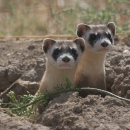Questions and Answers: Black-footed Ferret Cloning Research update
April 17, 2024
Related: News Release - U.S. Fish and Wildlife Service and Partners Announce Innovative Cloning Advancements for Black-footed Ferret Conservation
-----------------------------------------------------------------------
Why clone black-footed ferrets?
- The successful cloning of previously unrepresented genes is a significant step forward for our black-footed ferret recovery efforts. The foundation of present recovery efforts has been made possible by the captive population lineage that is descended from seven distinct genetic founders. These seven founders were among those captured from the remaining black-footed ferrets in Meeteetse, Wyoming, in the late 1980s. Extant populations, both captive and reintroduced, descend from these founder animals. With only seven genetic founders, the genetic diversity of the black-footed ferret has been a concern in the captive breeding program. The introduction of novel, currently unrepresented genetic material may provide a significant boost to the genetics of the current black-footed ferret population.
Why is it so important for species to have genetic diversity?
- Without an appropriate amount of genetic diversity, a species often becomes more susceptible to diseases and genetic abnormalities, as well as limited adaptability to conditions in the wild and a decreased fertility rate. Limited genetic diversity makes it extremely difficult to fully recover a species.
How are black-footed ferrets doing in the wild today?
- Black-footed ferrets have been reintroduced in the wild at 34 sites across eight states, as well as in Canada and Mexico. Due to the black-footed ferret’s nocturnal and fossorial (living underground) nature, their large range across the West and the population’s natural ebb and flow due to environmental stressors such as disease, it is difficult to determine exactly how many animals are on the landscape at any time. A major concern for black-footed ferrets in the wild are natural and introduced diseases, such as sylvatic plague. Current data suggest there are several hundred black-footed ferrets currently living in the wild.
What genetic material was used?
- The genetic tissue comes from a black-footed ferret named Willa, captured around the time of the species’ rediscovery. This black-footed ferret never successfully reproduced and therefore is not represented in the current captive breeding population.
Will these black-footed ferret clones be released into the wild?
- No, these individuals will remain at the National Black-footed Ferret Conservation Center for monitoring and additional research to assess fitness and compare them to extant individuals.
If black-footed ferret cloning is successful, how will this help other species?
- Current efforts are focused on addressing a specific genetic diversity concern associated with the black-footed ferret. These efforts are only in the preliminary stages of determining how this cloning technology will assist in the future genetic management of black-footed ferrets. The Service views this new potential tool as one of many available to help recover the species while also working to address habitat and other challenges to recovery. The Service is not currently engaged in genetic cloning efforts for any other species.
If the Service can successfully clone black-footed ferrets, does the conservation of wild populations and habitats become less critical?
- Maintaining and increasing wild populations and suitable habitat continues to be essential for black-footed ferret recovery and will remain a priority for the Service. Successful genetic cloning does not diminish the importance of addressing habitat-based threats to the species or the Service’s focus on addressing habitat conservation and management to recover black-footed ferrets.
What are the next steps in cloning black-footed ferrets?
- Researchers plan to continue cloning efforts in the coming month to begin breeding trials. At this time cloned black-footed ferrets will remain at the National Black-footed Ferret Conservation Center and Smithsonian’s National Zoo & Conservation Biology Institute for continued research and monitoring, there are no current plans for releasing cloned individuals into the wild.



